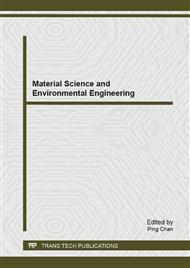[1]
P. C. Andricacos, C. Uzoh, J. O. Dukovic, J. Horkans and H. Deligianni, Damascene copper electroplating for chip interconnections, IBM J. Res. Dev., 42(1998) 567-574.
DOI: 10.1147/rd.425.0567
Google Scholar
[2]
Q. X. Shen, X. Wang, H. P. Zhu, Effect of additive triblock copolymer EPE-8000 on bottom-up filling in copper electroplating, Int. J. Electrochem. Sci., 9 (2014) 365-370.
Google Scholar
[3]
W. P. Dow, H. S. Huang and Z. Lin, Interactions Between Brightener and Chloride Ions on Copper Electroplating for Laser-Drilled Via-Hole Filling, Electrochem. Solid State Lett., 6(2003) C134-C136.
DOI: 10.1149/1.1595311
Google Scholar
[4]
S. Miura and H. Honma, Advanced copper electroplating for application of electronics, Surf. Coat. Technol., 169(2003) 91-95.
Google Scholar
[5]
W. P. Dow, M. Y. Yen, W. B. Li, and S. W. Ho, Influence of Molecular Weight of Polyethylene Glycol on Microvia Filling by Copper Electroplating, J. Electrochem. Soc., 152(2005) C769-C775.
DOI: 10.1149/1.2052019
Google Scholar
[6]
W. P. Dow, H. S. Huang, M. Y. Yen and H. C. Huang, Influence of Convection-Dependent Adsorption of Additives on Microvia Filling by Copper Electroplating, J. Electrochem. Soc., 152( 2005) C425-C434.
DOI: 10.1149/1.1901670
Google Scholar
[7]
W. P. Dow, M. Y. Yen, C. W. Liu and C. C. Huang, Enhancement of filling performance of a copper plating formula at low chloride concentration, Electrochim. Acta, 53(2008) 3610-3619.
DOI: 10.1016/j.electacta.2007.12.048
Google Scholar
[8]
S. K. Kim and J. J. Kim, Superfilling Evolution in Cu Electrodeposition: Dependence on the Aging Time of the Accelerator, Electrochem. Solid State Lett., 2004, 7, C98-C100.
DOI: 10.1149/1.1777552
Google Scholar
[9]
K. Kondo, T. Matsumoto and K. Watanabe, Role of Additives for Copper Damascene Electrodeposition: Experimental Study on Inhibition and Acceleration Effects, J. Electrochem. Soc., 151( 2004) C250-C255.
DOI: 10.1149/1.1649235
Google Scholar
[10]
A. Pohjoranta and R. Tenno, A Method for Microvia-Fill Process Modeling in a Cu Plating System with Additives, J. Electrochem. Soc., 154(2007) D502-C509.
DOI: 10.1149/1.2761638
Google Scholar
[11]
J. W. Gallaway, M. J. Willey, A. C. West, Acceleration Kinetics of PEG, PPG, and a Triblock Copolymer by SPS during Copper Electroplating,J. Electrochem. Soc., 156 (2009)D146-D154.
DOI: 10.1149/1.3078405
Google Scholar
[12]
J. W. Gallaway ,M. J. Willey, A. C. West, Copper Filling of 100 nm Trenches Using PEG, PPG, and a Triblock Copolymer as Plating Suppressors, J. Electrochem. Soc., 156(2009) D287-D295.
DOI: 10.1149/1.3142422
Google Scholar
[13]
J. W. Gallaway, A. C. West, PEG, PPG, and Their Triblock Copolymers as Suppressors in Copper Electroplating, J. Electrochem. Soc., 155(2008) D632-D639.
DOI: 10.1149/1.2958309
Google Scholar


